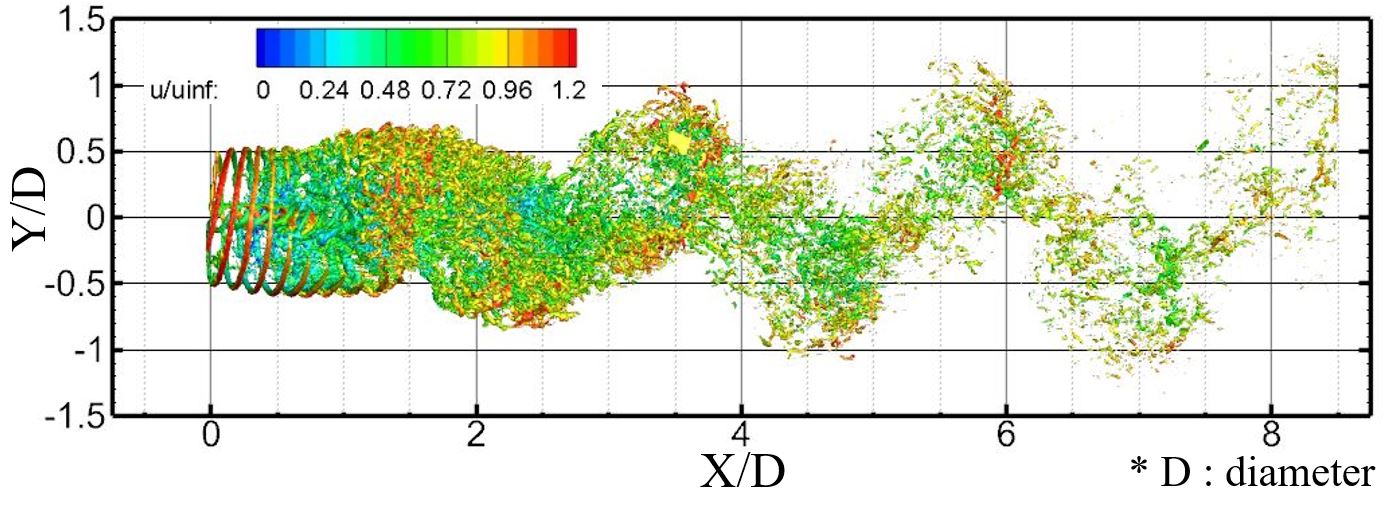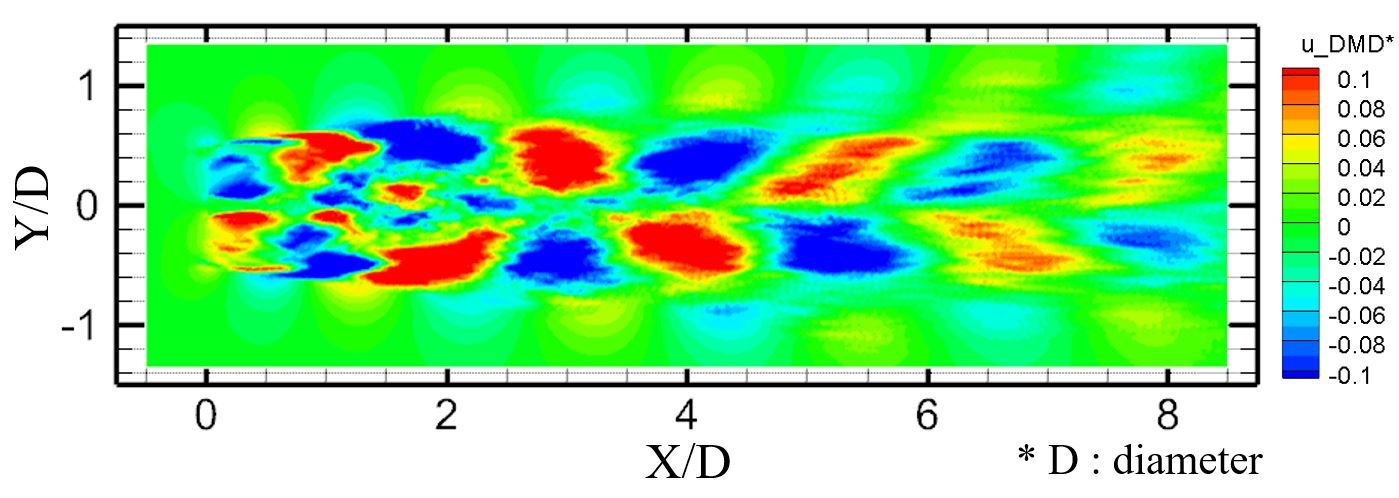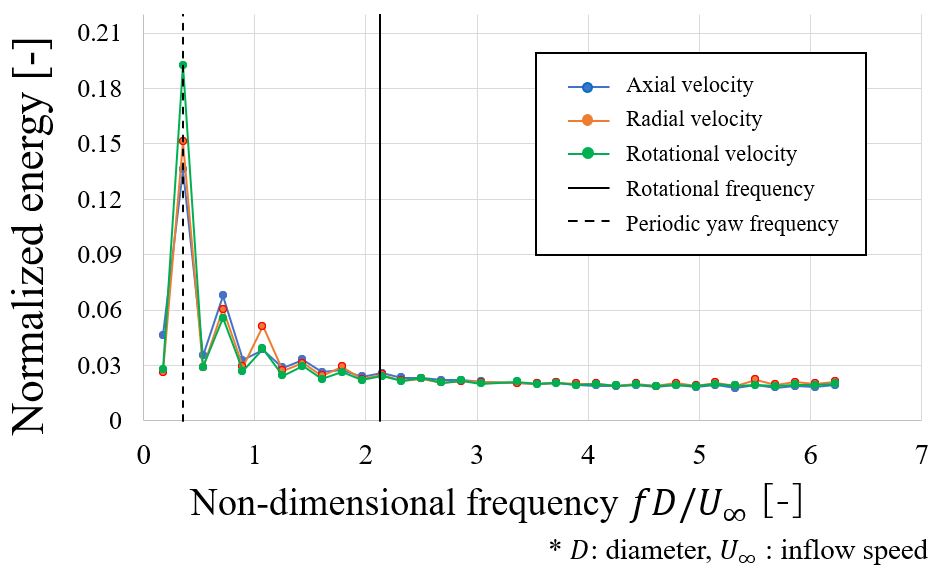CFD analysis of wind turbine wake
JAXA Supercomputer System Annual Report April 2019-March 2020
Report Number: R19ETET09
Subject Category: Skills Acquisition System
- Responsible Representative: Yasutada Tanabe, Leader, High Speed Rotorcraft Research Section Aviation Systems Research Unit Aeronautical Technology Directorate
- Contact Information: The University of Tokyo, Keita Kimura(k.kimura@ilab.eco.rcast.u-tokyo.ac.jp)
- Members: Keita Kimura, Yasutada Tanabe
Abstract
In a large wind farm (arrays of wind turbines), a wind turbine wake can cause power deficits of turbines stand in wake region. Because of that problem, Interests of recovery of wind speed in wind turbine wakes has emerged these days. In this study, several wake simulations were performed to obtain the characteristics of wind profiles in wind turbine wakes. We focused on scales and frequencies of wind fluctuations in wake regions in order to investigate the relations to recovery of wind speeds in wake regions.
Reference URL
N/A
Reasons and benefits of using JAXA Supercomputer System
In wind turbine wake simulations, comtutational domain should cover about 10 rotor diameters downwind because of its large impact range. On the other hand, to resolvethe fluctuations from rotational blades, grid scales need to be the order of chord length of blade tips. As a result, it is necessary to put large computational grid which has high grid resolution. Thanks to JSS2, such simulations of high computational cost can be performed.
Achievements of the Year
CFD simulations of a wind turbine were carried out by changing yaw angle periodically. Periodic changes of yaw angle can put wind fluctuations which scales are as large as the diameter of a turbine. All simulations are performed by using rFlow3D, which is designed for analysing rotational crafts. Fig.1 shows iso-surfaces of vorticity contours in a periodic yaw condition. Wake meandering caused by periodic change of yaw angle can be seen in this picture. Then, in order to focus on each scales and frequencies of wind fluctuations, dynamic mode decomposition (DMD) analysis is applied to the velocity fields and principal modes in velocity fields are captured. Fig.2 depicts a example of principal mode captured by DMD analysis. Periodic wind fluctuations based on diameter scale are confirmed in this figure. Finally, Fig.3 shows a power spertrum derived from DMD analysis. The frequnency of the principal mode (a peak value) is around the frequency of changing yaw angles. According to the such kinds of analyses, it turned out that fluctuations based on wind turbine scales are greater effects on the recovery of wind speeds than tip vortex breakdowns.
Publications
– Peer-reviewed papers
1) Keita Kimura, Yasutada Tanabe, Yuichi Matsuo, and Makoto Iida. “Forced wake meandering for rapid recovery of velocity deficits in a wind turbine wake”, AIAA Scitech 2019 Forum, AIAA SciTech Forum, (AIAA 2019-2083)
2) Keita Kimura, Yasutada Tanabe, Makoto Iida “A numerical study of the wake interference and loss of energy for WPP”, Journal of Wind Energy, JWEA, Vol.43 No.3(serial No.131), 2019.
Usage of JSS2
Computational Information
- Process Parallelization Methods: MPI
- Thread Parallelization Methods: OpenMP
- Number of Processes: 1 – 8
- Elapsed Time per Case: 400 Hour(s)
Resources Used
Fraction of Usage in Total Resources*1(%): 0.49
Details
Please refer to System Configuration of JSS2 for the system configuration and major specifications of JSS2.
| System Name | Amount of Core Time(core x hours) | Fraction of Usage*2(%) |
|---|---|---|
| SORA-MA | 292.36 | 0.00 |
| SORA-PP | 1,354,329.74 | 8.77 |
| SORA-LM | 0.00 | 0.00 |
| SORA-TPP | 0.00 | 0.00 |
| File System Name | Storage Assigned(GiB) | Fraction of Usage*2(%) |
|---|---|---|
| /home | 96.23 | 0.08 |
| /data | 10,653.41 | 0.18 |
| /ltmp | 2,130.68 | 0.18 |
| Archiver Name | Storage Used(TiB) | Fraction of Usage*2(%) |
|---|---|---|
| J-SPACE | 0.00 | 0.00 |
*1: Fraction of Usage in Total Resources: Weighted average of three resource types (Computing, File System, and Archiver).
*2: Fraction of Usage:Percentage of usage relative to each resource used in one year.
JAXA Supercomputer System Annual Report April 2019-March 2020





